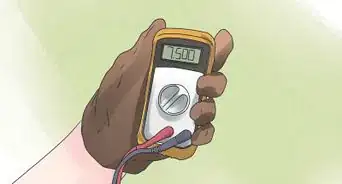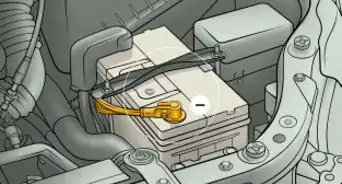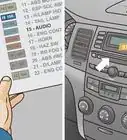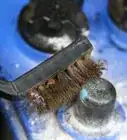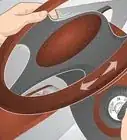X
wikiHow is a “wiki,” similar to Wikipedia, which means that many of our articles are co-written by multiple authors. To create this article, 11 people, some anonymous, worked to edit and improve it over time.
This article has been viewed 130,655 times.
Learn more...
Before checking the ignition coil, ensure there is 12V going to the terminal 15 on the coil. Note: Terminal 15 is positive, terminal 1 is negative. Turn your ignition switch to "on" and put a test light or meter on the coil, one lead to plus, the other to minus. The light should go on or the meter should indicate the voltage. Use extreme caution.
Steps
-
1Be sure to have a fire extinguisher nearby![1]
-
2Use extreme caution.Advertisement
-
3Pull the wire out of the center of the distributor with a rubber handled pair of pliers, and hold it about 1/4" from the metal clips that holds the distributor cap on.
-
4Have someone crank over the engine.[2]
- There should be a nice blue spark that goes from the end of the wire you pulled out of the center of the cap to the metal clip.
- It should look and sound strong, and should be easy to see, even in daylight.
- If the spark looks thin and weak (yellow is weak, blue is strong), then the coil winding may be giving out.
- There should be a nice blue spark that goes from the end of the wire you pulled out of the center of the cap to the metal clip.
-
5Use an Ohmmeter to test the coil.[3]
- Remove all the wires taken off the terminals of the coil attach the positive and negative, red and black, wires of the meter to first the terminal 15 (positive) and 1 (negative) that are stamped on the coil.
- A reading of at least 3 - 4.5 ohms, indicates a good coil.
- A bad coil will show a higher reading then 3 - 4.5 ohms.
- Place the red or black lead from the meter to the center of the coil (secondary post), and to either one of the terminals, 1 or 15 on the coil.
- A reading of 9,500 - 10,000 Ohms, sometimes less, indicates a good coil.
- A reading of 11,000 Ohms or more, or a reading of zero indicates a bad coil.
- Remove all the wires taken off the terminals of the coil attach the positive and negative, red and black, wires of the meter to first the terminal 15 (positive) and 1 (negative) that are stamped on the coil.
Advertisement
Community Q&A
-
QuestionHow many volts go through a 1972 Beetle coil?
 Community Answer17.5 to 18,000 v max. A spark plug will only ask for just enough voltage to fire, and depending on the condition of the ignition system, as low as 3000 v up to coil max. If a plug is demanding 30,000 v to fire, you have high resistance trouble. Very high firing voltage can damage rotors, caps, and spark plug wires.
Community Answer17.5 to 18,000 v max. A spark plug will only ask for just enough voltage to fire, and depending on the condition of the ignition system, as low as 3000 v up to coil max. If a plug is demanding 30,000 v to fire, you have high resistance trouble. Very high firing voltage can damage rotors, caps, and spark plug wires. -
QuestionMy 1972 Bug has no spark. Yesterday, it ran perfectly. What could be the problem?
 Community AnswerMaybe your timing is off.
Community AnswerMaybe your timing is off. -
QuestionI have a 1974 Beetle and have fire going to the coil, but not to the distrubutor. I pulled the coil plug from the distrubutor, but nothing happened. What can I do?
 Community AnswerHave your spark plugs checked. If you don't want to go to a car repair shop due to high maintenance cost, do it yourself. If you don't know how to do this yourself, there are many tutorial articles and videos online.
Community AnswerHave your spark plugs checked. If you don't want to go to a car repair shop due to high maintenance cost, do it yourself. If you don't know how to do this yourself, there are many tutorial articles and videos online.
Advertisement
Warnings
- Use extreme caution and be sure to have a fire extinguisher nearby!⧼thumbs_response⧽
- Safety should always be your #1 focus when working on a vehicle. Absolutely nothing in this world is so important, that you should ever practice unsafe maintenance on your vehicles. Always use the proper tools for the job at hand. Common sense is a very important in following any directions for maintenance.⧼thumbs_response⧽
Advertisement
References
About This Article
Advertisement





